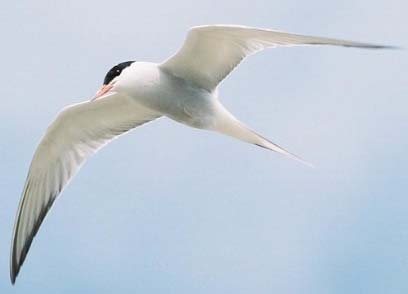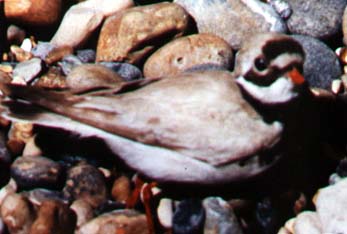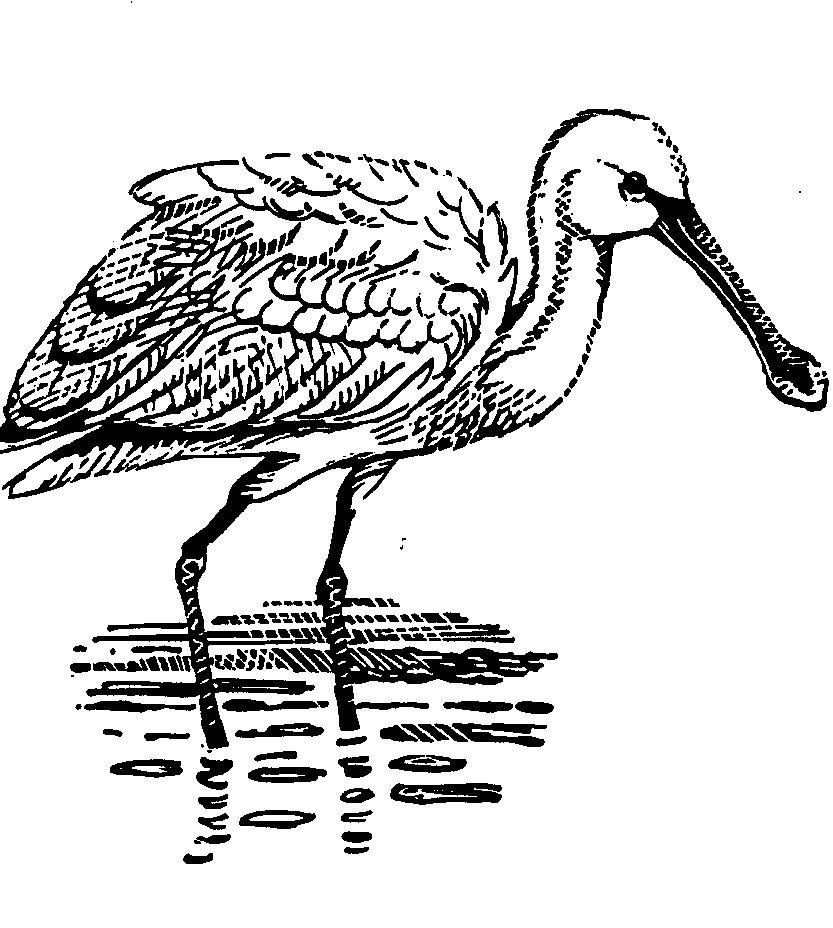 11
June 2001 11
June 2001
Offshore
from Brooklands Boating Lake, Common Terns,
with their distinctive forked tails, swept low over the sea that was showing
the first signs of white horses, and descended to take a feed from just
below the surface in one swift swoop. Black-headed
Gulls, in breeding livery with a completely
dark (brown) head, were attempting the same manoeuvre without the same
elegance. A half dozen Cormorants congregated
around the post marking the outlet pipe, occasionally diving under. This
is a regular flocking area for these fish eating birds with frequently
up to 29 birds that can be quickly counted.
Sea
Birds Portfolio (Photographs by Nicolas Jouault)
The
Ringed
Plover reveals itself by its swift running
over the shingle. Without moving it is too well camouflaged and difficult
to spot. The summer residents birds and much plumper than the lean winter
visitors. As the tide ebbs and the water recedes, more (a half dozen in
50 metres of sand) of these small birds appear on the emerging sand flats.
Pink-footed
Geese
One
of the most fabulous wildlife spectacles in North Norfolk are the massive
flocks of Pink-footed Geese, Anser
brachyrhynchus. This is a fairly recent phenomena. In the seventies
only a few thousand wintered in the whole of Norfolk.
The nineties saw the largest
leap in numbers with an estimated 76,000 in North Norfolk alone in 1997-98.
Birdline
East Anglia Report (extract) for December 1999 by Robin Chittenden
Phone Birdline East Anglia
on 09068 700 245
for all the bird news in
East Anglia & National rarities.
Phone Wildlife Newsline
on 09068 700 254.
Please phone in your sightings
on 01603 763388. Enquiries 01603 633326
e-mails: birdline.eastanglia@virgin.net
& wildlife.newsline@virgin.net
Harlequin Pictures, 65 Sandringham
Road, Norwich NR2 3RZ
e-mail: harlequin.pictures@virgin.net
Calls to 09068 Numbers charged
at 60p/min.
Bird
News
Ringed
Plover
Hello
Birders,
I am
trying to investigate the reason why the Ringed Plover often fails
to bring up its young in the vicinity of humans.

It
is a shingle nesting bird. Several possibilities have been suggested:
Humans
get to near the nest, frighten the bird off a or trample the eggs. I would
expect this to occur when public pressure on the beach is too great.
However,
often this little bird persists quite near seafront houses and other possibilities
I wish to consider.
These
include:
1)
Dogs sniff out the nest.
2)
Cats catch the birds or find the nest.
3)
Crows find the nest and eggs.
4)
Foxes get the nest and young.
Does
anybody know of any research that has been undertaken on this subject,
or failing this, has anybody got any anecdotal observations.
The
nests are difficult to discover, but sometimes small indentations in the
shingle are all that remains of an attempted nest site. Often, the first
indication is the feigning behaviour when the Ringed Plover attempts to
distract anybody or any animal that ventures too close.
Cheers
Andy
Horton
Coastal.htm
Ringed
Plover nests are susceptible to many predators, but fox, badger and carrion
crows are probably the major problems here at Rye Harbour. Barry
Yates ( Rye Nature Reserve)
EMail:
yates@clara.net
Rye
Harbour Nature Reserve
I would
put the most likely causes of Ringed Plover breeding failure, as seen from
our windows overlooking the shingle beach, as 1. CROWS, 2. Foxes, 3. Dogs,
4. Human disturbance, 5. Other reasons. David
Wood (Shoreham Beach)
Hi
Andy,
I
saw your message about Ringed Plovers on the BMLSS
forum page.
I've
just been working as a warden on a reserve monitoring breeding success
of birds: amongst them ringed plover.
I
found that even if predators do not find the nest, and it is not trampled
on, the birds often failed to raise young in areas with a lot of disturbance
because of their method of trying to protect their nest. a good example
of this is a bird who nested outside my caravan right on the footpath across
the island. Every time I stepped outside or walked past my window, the
bird got off it's nest so causing chilling of the eggs. Eventually, after
a longer than average incubation time, 2 eggs did hatch, but every time
a person was near, the parents would run off down the beach doing a broken
wing act worthy of an oscar nomination but completely abandoning the chicks
and leaving them at the mercy of predators. The parents spent so much time
doing this that the chicks did not have enough feeding time, I don't think,
and did not survive long.
Hope
that is of some interest. I'd love to know your findings. I'm constantly
battling with fishermen and dog walkers trying to prevent disturbance.
Good
Luck
Jenny
Holden
November - December 1999
A Spoonbill, Platalea
leucorodia, is a regular at Rat Island and for the last 8 years they
have been wintering on the Lynher, Cornwall. The best places to see them
are Whacker Quay and Sconer.
 27
November 1999 27
November 1999
An American Wigeon and Spoonbill are seen on the Hayle Estuary, Cornwall.
Reports from Vince Smith, Joe Higman, Vince
Smith's One-List/Cornish Wildlife
Send a message to the list at: CornishWildlife@onelist.com
15 September 1999
A Spoonbill was seen at Sidlesham Ferry, Sussex.
(from
Sussex Ornithological Society)
Little
Egrets, Egretta egretta, in Cornwall
We certainly do get Little
Egrets here in Cornwall, my own experience is on the Helford River, where
I am the KDC Water Bailiff. On one day during the summer I counted 49 over
3 sites, at Calamansack, Polwheveral Creek and at Bonallack, near Greek.
They also seem to be spreading down the river towards the entrance. I have
also seen the odd bird inland at Stithians Reservoir. Other places with
multiple occupancy are The Truro/Fal Rivers, Hayle Estuary and on the Fowey
River. Most of these sites are only visible from the water, particularly
on the Helford. I am sure that other subscribers will let you know
of other sites.
Nigel
Knight"
Nigel Knight and Jon Makeham
have also reported Little Egrets regularly from Hannafore Point, Looe.
The maximum number of Little
Egrets on the Tamar/ Lynher complex is 230, this was about five years ago.
Since then numbers have peaked at around 160-170 mostly in September when
the post-breeding dispersal takes place.
As for wintering birds,
around 30-40 spend the winter on the estuary and are best seen from Wacker
Quay or Sconner Corner.
Darrell Clegg 1999
City of Plymouth Library
and Information Services
http://www.plymouth.gov.uk/star/library.htm
EMail: cleggd@plymouth.gov.uk
Report posted on Vince
Smith's One-List/Cornish Wildlife
Little
Egret in the Adur Estuary
Little
Egrets (RSPB)
Sanda Island Scotland
http://www.axs2000.net/belrick/sandaIndex.html
The little island of Sanda sits at the convergence of the Irish sea
and the Forth of Clyde, just to the east of the Mull of Kintyre. The island
is only about 1/2 mile in diameter, there are two land falls, one on the
north by the house and the other by the unmanned lighthouse at Prince Edward's
rock.
Birdwatching
on the Dee Estuary
http://www.deeestuary.freeserve.co.uk/
Recommended Pages. Lots of information and photographs.
30
November 1999
Barry
Collins reported a roost of 146 Little
Egrets, Egretta egretta, on Thorney Island in Chichester
Harbour. This is large number for a bird that is not even included in most
modern bird books for Britain and Ireland.
More
Information (Brian Fellows site)
Little
Egret in the Adur Estuary
Up
until a few years ago they were vagrant, occasional visitors to the south
of England only, but they have been especially numerous this year, no doubt
attracted by the large shoals of
young Bass around this autumn.
This
bird has been recorded since 1826 on the south coast.
A
Black
Brant (Siberian Brent Goose), Branta bernicla nigricans, has
also been reported from Langstone Harbour. Havant
Nature Notes
October
1999
Birds
on the lower Adur estuary, West Sussex (click on the text for some interesting
local nature reports).
31
August 1999
Kingston Beach,
Shoreham
Another
humid heat wave, but it was cool enough to be pleasant at 8.30 am at the
lowest point of the spring tide. At Kingston Beach
the tide had gone out so the tide marker at Chart
Datum showed the depth at zero. The sea was as still as a mill
pond and clear. The seagulls, mainly the Black-headed Gull (with
red legs, the heads are mostly white), Larus ridibundus, were resting
on the sea and flying around and squawking. The numbers and the abundance
was unusual so there had to be a reason. Terns dived into the sea,
so there must be shoals of fry numbering millions of small fish.
 25
August 1999 25
August 1999
3
Little Egrets,
their distinctive all white colouring stood out from the greenery (Glasswort)
and they were right in the middle of the Adur mudflats,
Shoreham-by-Sea, West Sussex, (between the footbridge and the Norfolk
Bridge), sometimes hidden in the dips of the channels. The tide was low
in the mid-afternoon. In addition 7 Grey Herons were perched as
still as statues. All the birds were too far away for photographs even
with a 500m mirror lens. The light was poor in the middle of a thunderstorm
and a downpour.
There
has been abundance of small Grey Mullet in the river this year.
Egret
Information Update
22
August 1999
David
Roberts (Shoreham Beach) reported a Little Egret, Egretta garzetta,
from the mudflats near the houseboats. It was on the remaining mud at about
the maximum low neap tide (minimum range, high tide 4.7 metres) at 3.00
pm BST.
15
June 1999
A Common
Crane, Grus grus, was spotted at Aith in the Shetland
Islands during the evening. On the 22th it was seen at Eswick on the East
Mainland (of the Shetland Isles).
This
bird species has been seen feeding on the salt marshes of the River
Adur, Sussex, in the past.
June
1999
An Osprey,
Pandion
haliaetus, is hunting around Thorney Island, (the peninsula sticking
out in the middle of Chichester Harbour, West Sussex) near where
there is a roost of 10 Little Egrets,
Egretta
egretta.
Havant
Nature Notes
31
January 1998: A Common Gull, Larus canus, was
observed by Andy Horton (it was pointed out to him)
through a powerful telescope, at Widewater Lagoon
near Shoreham-by-Sea, Sussex just after midday
standing on a pole in the brackish shallows. This particular bird in adult
plumage was distinguished by a prominent black tip to its beak on
the left side, and a lesser smudge on the right beak. The legs of this
bird were bright yellow. The black beak markings of the juveniles are not
included in most popular books with the notable exception of the Reader's
Digest Nature Lovers guide. The clearly viewed markings on the right hand
side of this bird were consistent with the Common Gull and not the ringed
bill of the rare American vagrant the Ring-billed Gull, Larus delawarensis.
This vagrant bird has been reported on six occasions from Sussex during
the 1980's.
NB. I am second thoughts
about the identification; the bright yellow legs were most distinctive!
On the third thoughts,
the Hamlyn Guide to British & European Birds, shows a much thicker
bill for the American alien. I stick with my original view. The black markings
on the beak are not diagnostic enough on their own. This particular bird,
a Common Gull, squawked when it flew. The bird resembles Common Gulls I
have seen since.
NB:
I am not so sure now. I have just discovered a photograph
that looks a bit like the gull on Widewater (except for the eyes).
January
1999. Another Ring-billed Gull has been reported from the
coast east of Brighton, Sussex.
Separating
adult Common and Ring-billed Gulls should be straightforward. I don't
have much experience of R-b Gull in the UK (I've seen it four or five times)
but I've seen plenty in Canada.
R-b
Gull is generally a larger and bulkier bird than Common Gull and resembles
a small Herring Gull, with a paler mantle and different mirror pattern
from Common Gull. Common Gulls do sometimes show yellow legs.
R-b
Gull also has the same fierce facial expression as Herring Gull, rather
than the "big-eyed" look of Common Gull. The bill is a different
shape too, its blunt and the top and bottom are parallel, Common Gull has
a more pointed, needle-like bill.
On
the closed wing Common Gull shows a wide crescent of white before the black
tip while R-b Gull has a neater, arc.
Try
the Macmillan Guide to Bird Identification for more detail.
Cheers
David
Kelly
Lothian
Bird Recorder & Editor Lothian Bird Report
Prestonpans
East Lothian Scotland
dj_kelly@lineone.net
Oystercatchers

The first few months of
1998 were rather sparse as far as the life on the Sussex shores were concerned.
The low spring tides occur at dawn and dusk and in the low light even the
bright red beaks of the Oystercatchers as they probe in the sand are not
very clear. At Kingston beach, Shoreham-by-Sea
by the Lighthouse, these birds have a choice to probe amongst the mussels,
or even stab these stationery bivalves to get at the rich orange flesh,
or to unearth the cockles beneath the surface, or to feed on small crabs
or winkles. However, it is rather disappointing that the visiting birds
always seem to occupy the sand and mud flats where they feed on worms.
They are more likely to be seen on inland playing fields than amongst the
mussel beds.
All illustrations by Chris Hicks
(Northolt, Middx.).
Black Guillemots
breed in Bangor Harbour, Northern Ireland.
22 July 1998
Little Egrets, Egretta garzetta,
spotted flying over Brighton, Sussex. These birds are an unusual occurrence
on the northern English Channel coast (Sussex) but reports seem to becoming
commoner.
 From Ian Lawes (Compuserve Forum). Could have
been a Cattle Egret.
From Ian Lawes (Compuserve Forum). Could have
been a Cattle Egret.
This bird is not included in some general
books of British Birds; it should be!
Underwater
Predators:
A Seal (Tenby) and a Porbeagle Shark (Channel
Islands) have been reported feeding on a seagull on the surface of the
sea.
White-tailed Eagles
are
breeding on the Isle of Skye, but they are rarely
seen. On the Isle of Mull they have developed a taste for fit and healthy
young lambs. The eagles are breeding and the numbers have increased to
200 from the 150 originally introduced. They compete with Golden Eagles
for prey.
-
8 November 1997. A White-tailed Sea Eagle, Haliaetus albicilla,
is spotted by Andy Fitchett in the Shetland Isles. For more information
access:
-
Shetland Islands Wildlife
News
5 December 1999
BBC 2 Television
Simon King's Living Britain
-
included some splendid film of theWhite-tailed
Sea Eagle on Skye.
-
They followed the fishing boats for a free fish meal.
-
December 1999
A White-tailed Sea Eagle, Haliaetus
albicilla, was observed out of its normal
range (re-introduced to Scotland) on several occasions throughout the month,
in Norfolk.
29 September 1998
A Spoonbill, Platalea
leucorodia, was spotted on the small flooded area next to the ferry
terminal at Symbister on Whalsay, Shetland Isles. This large and very white
bird with its characteristic large spoon-shaped bill was discovered during
the early evening and was happily 'spooning' through the water right alongside
the road. It is only the fourth record of the species in Shetland and only
the second record this century.
More information on the Shetland
Wildlife News Web Site

The bill shape is the real give away, as there are no similar species
visiting our shores. All the other large waders, such as egrets and herons,
have a more conventional profile. Even juvenile Spoonbills retain the distinctive
bill (a paler scaled down version). The non-breeding plumage is pure white,
but the breeding birds exhibit a sandy bib and rather eccentric looking
crest, and the juveniles have black wing tips. In flight they are slow
and graceful, with necks and legs outstretched.

Although a rare visitor, it turns up fairly regularly in suitable habitats,
where there are large areas of shallow water and reed beds. The RSPB reserve
at Minsmere often plays host to one or two adult birds during the summer
months, when it is fairly conspicuous, as it is not a bird that tends to
skulk around the undergrowth like some of the shyer waders.
by Chris Hicks (Northolt)
DEFRA
Cormorants page
|




Ivory
Gull feeding on the carcass on 10
February 2002
